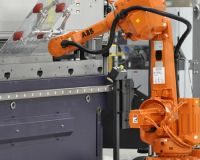IMTS Preview: ABB Robotics

ABB Robotics will feature a unique set of robotic automation demos, highlighting products, systems and technology designed to increase manufacturing productivity for operations of varying sizes and needs at the International Manufacturing Technology Show (IMTS) 2012, September 10-15 at McCormick Place in Chicago. Included at booth #6770 in the North Hall will be:
Okuma Machining Cell tended by an IRB 2600 Robot: A machining cell featuring an ABB IRB 2600 robot with a Schunk pneumatic, three-finger centric gripper tending an Okuma Genos L200E-M lathe; a multifunction machining unit with a horizontal way system suited for a variety of parts up to 7.87" in diameter and 14.96" in length. The simulation shows the speed and accuracy in which the robot moves a small pre-machined valve body in and out of the machining center. Enabled by ABB's IRC5 Controller with QuickMove technology, the IRB 2600 completes the process up to 30% faster than comparable competitive robot models. ABB has recently joined the Okuma Partners in THINC, a network of companies that collaborate to solve problems and explore new productivity ideas for metal-cutting and manufacturing industries. ABB and Okuma recently designed a software package to integrate the programming and controls of a robot in combination with a machine tool, delivering a more seamless interface for the system operator. The PC application allows the operator to control the entire system through one common user platform.
Four Robot Simulated Production Cell: A simulated production cell comprised of four ABB robots of differing sizes, reaches and payloads highlighting the accurate coordination of complex motion patterns the MultiMove function of ABB's IRC5 controller enables. Utilizing a single controller, the MultiMove standard programming instructions move the robots in fully coordinated motion to collaboratively work on the same part or within the same manufacturing process. MultiMove also allows the robots to move independently of each other or in subgroups of any combination. The agility and accuracy of the robots is enhanced by ABB's Absolute Accuracy option which bridges the gap between the virtual robots in system simulation programs like ABB's RobotStudio and real robots on the factory floor. The accuracy enhancement is achieved by calibrating the robot arm to compensate for the natural deflection that comes with payload and motion variables. This is especially valuable for high end performance applications like laser cutting, precise movements using vision technology and, as in the demo, multiple robots moving together. The cell is fully enclosed in ABB Jokab Safety fencing and includes the following robots:
- An IRB 4600 60 kg (payload)/2.05 mm (reach) handling a large part.
- An IRB 120 3 kg/0.6 mm carrying a small subcomponent to the main assembly.
- An IRB 2600 12 kg/1.65 mm with a Binzel welding torch and a Meta vision laser sensor utilizing Ethernet based communication with the robot. Meta is a leading manufacturer of laser vision systems for welding applications.
- An IRB 140 6 kg/0.8 mm searching for a part with a 1D laser sensor. 1D laser sensing is a next generation technology designed for fast, accurate and reliable edge, joint and part detection.
Haas Machining Cell tended by an IRB 4600 Robot: A machining cell with an ABB IRB 4600 tending a Hass SL-10 CNC Lathe, a small footprint turning center with a healthy 14" length x 14" diameter maximum capacity. With an SAS Automation vacuum gripper the IRB 4600 picks raw material from a feeder and loads the lathe after removing a completed aluminum "coin" from the chuck. Compressed air is used to blow off coolant and machining chips during the transfer process. The finished parts are then dropped off on a chute for additional processing or packaging. The cell, which is also enclosed in ABB Jokab Safety fencing, demonstrates how an ABB robot featuring ABB's RobotStudio Machine Tending PowerPac software can significantly improve cycle time and product quality. The robot and lathe are from Vincennes University (VU) in Vincennes, IN. ABB and VU partnered in 2009 to establish an enhanced robotic training center at the Indiana Center for Applied Technology (ICAT) on the VU campus. The robotic lab features 23 ABB robots and related work cells, software and controllers. "Robotic automation is at the forefront of the lean technologies manufacturers have embraced to increase productivity and gain a competitive advantage," said John Bubnikovich, executive director, marketing and business development, ABB Robotics. "Our IMTS demos highlight a range of emerging ABB robotic technologies, from entry level, almost turn-key systems for smaller companies to more intricate, highly engineered systems for larger operations."





